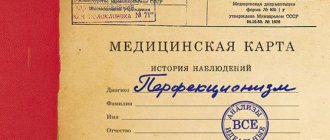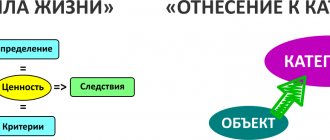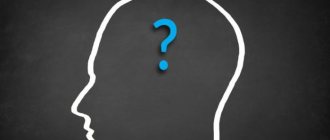Interpretation of the term
After doing a little research, we could not find a consensus on the question “what are ideals?” The definition can be completely different and ambiguous.
The problem is that for each individual who lives in a certain society, the interpretation of the term “ideal” is unique. A person follows his ideas, which are embedded in his subconscious. For some, these are ideals of external beauty, and for others, these are spiritual ideals. But you cannot treat them as a static phenomenon. For example, in childhood there may be ideals of a prince or princess. They will have certain character traits and appearance.
As the child grows older, these ideals begin to change. This needs to be taken quite seriously. Many children take for ideals images that are not ideal at all. The ideals that teenagers set for themselves are especially serious. For example, an action hero who breaks the law. Following one's ideal can lead a child to repeat the fate of his idol.
Sometimes a successful person is chosen as an ideal. By following his advice, you can achieve success in business yourself. The older generation considers veterans, heroes who saved their homeland and thousands of lives, as ideals and role models. But each person perceives ideals in his own way. Because everyone has their own value system.
Examples of the ideal
A description of the ideal can be found in fiction, painting, and architecture. But the problem is that in different eras a certain stereotype was taken as the highest point of perfection. The moral ideal can be external or internal. In works of literature, you can find many examples of how a person who has external beauty, for example Helen in War and Peace, may be far from ideal when it comes to his spiritual content. Thus, we are unlikely to find a single point of view on what ideals are.
The meaning of the word Ideal according to the Brockhaus and Efron dictionary:
An ideal is a representation of the highest perfection in some respect. In this broad sense, the word I. is applied equally to abstract and concrete objects: I. good, I. female beauty, I. state, I. citizen, etc. In this general sense, I. is usually opposed to reality,
like something imperfect.
This opposition can be taken in a threefold sense: 1) I., contrary to reality, can thereby be recognized as an empty fantasy. 2) a reality that does not correspond to I. can be unconditionally rejected as a false and illusory being and 3) the contradiction between these two terms can be understood as the task
of their reconciliation, that is, the transformation of reality according to I., or its embodiment in reality.
The first two views have a particular, relative truth, since there are situations that are essentially fantastic, and on the other hand, there is a reality that is also essentially worthless, incapable of improvement or re-creation. But the general fundamental truth belongs only to the third view: the totality of cosmic and historical experience points to reality that is realizable and being realized and to reality that is being transformed and being perfected. the entire history of the world and humanity is only the gradual embodiment of humanity and the transformation of a worse reality into a better one, and when arbitrary limits are placed on this process, this usually only means a secret preference for the bad over the good due to lower interests and passions. The concept of art is of particular importance in the field of pure art, which has as its task the embodiment of ideas in sensual forms, that is, the creation of concrete ideas (see Aesthetics). The word I. began to come into general use from the end of the last and beginning of this century, mainly thanks to Schiller. On the philosophical concept of God as absolute I., or I. of pure reason, see Kant. Vl. WITH.
Idea of the ideal from a philosophical point of view
The question of what ideals are has interested people since ancient times. Today, the concept of morality and culture is gradually losing its meaning. In the minds of adults, not to mention children, there is a real mixture of very different cultures and values. At the same time, society cannot develop normally if there are no lofty goals and ideals. The concept of a moral ideal is present in the Orthodox religion, on which the culture of Ancient Rus' was built. Children, in those days, were raised in accordance with the idea of the dogmas of the Orthodox Church.
Later, many philosophers, for example Lomonosov, studied ideals from their own points of view. It was their ideas that were incorporated into the system of raising children. The concept of the ideal can be found in the works of Kant, Pestalozza, and Ushinsky. The system of spiritual values is embedded in many works of fiction. But the fact is that at different times people answered the question of what ideals are in different ways. Every culture has its own values.
Wedding and the end of the fairy tale?
It would seem that this is a happy ending to the story, but no... After her fate improved, the woman deeply believed in principles that are akin to religious ones - they are implanted by modern psychologists. The postulates of this “religion” look something like this: “You are who you are. There is no need to improve yourself! The pursuit of perfection is neurosis and self-abuse. The constant striving for ideal is perfectionism, obsessive rituals with the help of which we try to improve something that makes no sense to improve.”
About moral ideals
If we analyze the concept from a philosophical point of view, we can find a division. There is an ideal, which is defined as the highest point, value, a certain system of moral concepts. In which the moral ideal is a system based on moral requirements. Their combination forms a certain image of a person’s personality. There are certain characteristics.
- From the point of view of the spiritual and moral system of values, ideals are models that are worthy of imitation. In this regard, examples can be given from fiction and spiritual literature. Many heroes have a number of characteristics that allow us to draw conclusions about their moral qualities.
- Throughout human evolution, the concept of “moral ideal” has constantly changed. Thus, in Ancient Greece, according to Aristotle, the ideal from a moral point of view was the ability of self-contemplation. A person had to renounce ordinary worldly life in order to achieve the highest point of perfection. Kant believed that the moral ideal is determined by the inner world of a person.
In order to perform actions that are worthy of an ideal personality, you need to be guided by certain rules. One way or another, every philosopher and psychologist has his own concept of what ideals are.
Man of different eras
Such universal human values as truth, goodness or love for others have always been valued, but the culture of different eras dictated its own conditions, so the standards of the ideal underwent the following changes:
- It was enough for a resident of the Ancient World to adhere to moral standards and not commit bad deeds. But to be considered ideal, you also need to be strong and healthy, like the Greek gods.
- The ideal of a person in the Middle Ages was presented in several versions: a meek and uncomplaining servant of God, an educated man, and a valiant and noble knight.
- The Renaissance valued people who strived for freedom and transformation of the world, but at the same time revered God as the Creator.
- Modern times were accompanied by the emergence of a person who knew how to use his mind, prone to free-thinking and at the same time capable of work;
- In the Soviet period, the ideal was the desire to sacrifice oneself for the common cause of building communism, to work hard and live according to conscience.
The modern world also dictates its demands on people. Now he does not necessarily have to be highly moral; pragmatism and successful career growth are more valued. But at the same time, considerable importance is attached to education and a craving for beauty, for example, reading books or visiting museums, as well as for good, primarily charity.
Human cultural values
A person lives in society. This or that society, if we consider it as a society, lives in accordance with its own rules and traditions, which are also called culture. A person cannot exist without a specific goal. It is culture that puts forward certain goals for the individual. This is not a scientific definition. Science identifies causes that exist in certain time periods. The goals that a person sets for himself allow him to predict the future. It is determined by the actions of the individual.
In the animal world there is no system of values from which the definition of what the ideals of culture is formed. But it exists in human society. Moreover, the goals that an individual sets for himself are largely determined by culture. The culture of a particular society is based on traditions. It develops at the genetic level. That is, it is passed on from generation to generation. Society sets a difficult task for a person - to preserve culture. Throughout the evolution of mankind, there have been a large number of different cultures. There was Chinese, Egyptian, Old Russian. Each of them cared about passing on its value system to the next generation.
Basic structures[ | ]
- Main ideals.
If
p
belongs to
R
and
k is
any integer, then { pr + kp : r ∈ R , k ∈ Z } {\displaystyle \{pr+kp:\,r\in R\ ,k\in \mathbb {Z } \}} - will be the minimal right ideal containing
p
, and { rp + kp : r ∈ R , k ∈ Z } {\displaystyle \{rp+kp:\,r\in R\ ,k\in \mathbb { Z} \}} is the minimal left ideal in
R
.
They are called, respectively, the principal right and left ideals generated by p
.
In the commutative case, these ideals coincide and are also denoted (p)
.
If the ring R
contains the identity element, then since kp = ( k ∗ 1 ) p = p ( k ∗ 1 ) {\displaystyle kp=(k*1)p=p(k*1)} , the principal ideals generated by
p ,
we can write p R = { pr : r ∈ R } {\displaystyle pR=\{pr:\,r\in R\}} and R p = { rp : r ∈ R } {\displaystyle Rp=\{rp :\,r\in R\}} respectively.
Every ideal containing an element p
also contains the main ideal generated by it.
- An ideal generated by many elements.
The intersection of an arbitrary family of left ideals of a ring
R
is a left ideal of the
ring
R.
,
for any subset M
of the ring
R
there is a minimal left ideal containing it, namely, the intersection of all left ideals containing the set
M. (The same is true for right and two-sided ideals.) For a ring R
with identity element, the minimal left ideal is the set of finite sums of the form r 1 m 1 + … + rnmn {\displaystyle r_{1}m_{1}+\ldots +r_ {n}m_{n}} , the minimal right ideal is the set of finite sums of the form m 1 r 1 + … + mnrn {\displaystyle m_{1}r_{1}+\ldots +m_{n}r_{n}} , minimal two-sided ideal - a set of finite sums of the form r 1 m 1 r 1 ′ + … + rnmnrn ′ {\displaystyle r_{1}m_{1}r'_{1}+\ldots +r_{n}m_{n}r '_{n}} , where
mi
are arbitrary elements of the set
M
, and
ri
,r'i
are arbitrary elements of the ring
R. If the ring does not contain a unit, then the minimal left ideal will have the form r 1 m 1 + … + rnmn + k 1 m 1 ′ + … + ksms ′ {\displaystyle r_{1}m_{1}+\ldots +r_{n }m_{n}+k_{1}m'_{1}+\ldots +k_{s}m'_{s}} , minimal right m 1 r 1 + … + mnrn + k 1 m 1 ′ + k 2 m 2 ′ + … + ksms ′ {\displaystyle m_{1}r_{1}+\ldots +m_{n}r_{n}+k_{1}m'_{1}+k_{2}m' _{2}+\ldots +k_{s}m'_{s}} , minimum two-sided r 1 m 1 r 1 ′ + … + rnmnrn ′ + k 1 r 1 ″ m 1 ′ + … + ksrs ″ ms ′ + k 1 ′ m 1 ″ r 1 ‴ + … + kt ′ mt ″ rt ‴ + k 1 ″ m 1 ‴ + … + kw ″ mw ⁗ {\displaystyle r_{1}m_{1}r'_{1} +\ldots +r_{n}m_{n}r'_{n}+k_{1}r»_{1}m'_{1}+\ldots +k_{s}r»_{s}m '_{s}+k'_{1}m»_{1}r»'_{1}+\ldots +k'_{t}m»_{t}r»'_{t}+k "_{1}m"'_{1}+\ldots +k"_{w}m"_{w}} , where all ki ( ki ′ ) {\displaystyle k_{i}(k'_{ i})} — any integers. These ideals are called generated by the
set
M. In the commutative case, they all coincide and are denoted as follows: (M)
. Ideals generated by a finite set are called finitely generated.
- The sum of ideals.
If an arbitrary family of ideals I α {\displaystyle I_{\alpha }} is given in a ring
R
, their sum ∑ I α {\displaystyle \sum I_{\alpha }} is the minimal ideal that contains them all. It is generated by the union of these ideals, and its elements are any finite sums of elements from their union (the union of ideals itself is usually not an ideal). With respect to the sum, all (left, right or two-sided) ideals of a ring (or algebra) form a lattice. Each ideal is the sum of the main ideals. Often, especially in commutative algebra, the sum is called the greatest common divisor).
- The intersection of ideals
(as the intersection of sets) is always an ideal.
On the other hand, the union of
two ideals is an ideal only if one of them is a subset of the other. Indeed, let a {\displaystyle {\mathfrak {a}}} and b {\displaystyle {\mathfrak {b}}} be two (left) ideals, neither of which is a subset of the other, and a ∪ b {\ displaystyle {\mathfrak {a))\cup {\mathfrak {b))} is a left ideal. In this case, obviously, a ∪ b {\displaystyle {\mathfrak {a}}\cup {\mathfrak {b}}} is the smallest ideal containing a {\displaystyle {\mathfrak {a}}} and b {\ displaystyle {\mathfrak {b))} , that is, a ∪ b = a + b {\displaystyle {\mathfrak {a))\cup {\mathfrak {b))={\mathfrak {a))+{\mathfrak {b}}} . There is an element a ∈ a , a ∉ b {\displaystyle a\in {\mathfrak {a}},a\notin {\mathfrak {b}}} . Then for any b ∈ ba + b ∉ b {\displaystyle b\in {\mathfrak {b}}\;a+b\notin {\mathfrak {b}}} , since in this case a ∈ b {\displaystyle a\in {\mathfrak {b}}} , therefore, a + b ∈ a {\displaystyle a+b\in {\mathfrak {a}}} and b ∈ a {\displaystyle b\in {\mathfrak {a }}} , so b ⊂ a {\displaystyle {\mathfrak {b}}\subset {\mathfrak {a}}} is a contradiction.
- A product of ideals.
The product of ideals
I
and
J
is the ideal
IJ
generated by all products
ab
, where
a
is an element of the ideal
I
,
b
is an element of the
ideal J. The infinite product of ideals is not defined.
- Particular ideals.
In a commutative ring, for an ideal
I
, different from zero, and an ideal
J
, their quotient is defined - ideal I − 1 J = { x ∈ R : ∀ i ∈ I ix ∈ J } {\displaystyle I^{-1}J=\{ x\in R\colon \,\forall i\in I\,ix\in J\}} .
This ideal is called the annihilator
of ideal
I
in the case when
J=(0)
, .
- The radical of an ideal I
is the set I = { f ∈ A : ∃ n ∈ N fn ∈ I } {\displaystyle {\sqrt {I}}=\{f\in A:\,\exists n\in \mathbb {N } \,\,f^{n}\in {I}\}} .
It is also an ideal of the ring A
, if only the ring
A
is commutative.
In the case when I=(0)
, this ideal is called the nilradical of the
ring
A. Its elements are all nilpotent elements of the ring. If a commutative ring has no nilpotent elements except zero (has a zero nilradical), it is called radical
.
An ideal I
is called radical if it coincides with its radical.
In this case, the quotient ring R/I
has no nilpotent elements except zero.
- Inductive limit
.
Given a family (chain) of ideals { I α } α ∈ A {\displaystyle \{I_{\alpha }\}_{\alpha \in A}} , numbered by a linearly ordered set A
, so that for any indices α < β {\displaystyle \alpha <\beta } from
A
the ideal I α {\displaystyle I_{\alpha }} is contained in the ideal I β {\displaystyle I_{\beta }} , then their union is an ideal - the inductive limit of a given chain of ideals .
This ideal also coincides with the sum of all ideals from the chain. The fact that the inductive limit always exists means that the set of all ideals of the ring R
is inductively ordered, and Zorn's lemma applies to it. It is often used to construct maximal ideals with some additional properties (see maximal ideal, simple ideal, principal ideal ring).
- The image of an ideal under a homomorphism.
Usually the image of an ideal under a homomorphism is NOT an ideal, but if the homomorphism is surjective, then it is. In particular, since a factorization homomorphism is always surjective, under factorization each ideal becomes an ideal.
- Preimage of an ideal under a homomorphism
.
If f : A → B {\displaystyle f:\,A\to B} is a ring homomorphism, its kernel
Ker f = { a ∈ A : f ( a ) = 0 } {\displaystyle \operatorname {Ker} f= \{a\in A:\,f(a)=0\}} is a two-sided ideal.
More generally, if I
is an arbitrary ideal in the ring
B
, its full inverse image f − 1 I = { a ∈ A : f ( a ) ∈ I } {\displaystyle f^{-1}I=\{a\in A: \,f(a)\in I\}} is an ideal (left, right or two-sided, depending on what the ideal of
I is
).
- Homomorphism of factorization by ideal.
If
I
is a two-sided ideal in a ring
R
, from it we can determine the equivalence relation on
R
according to the rule:
x~y
if and only if the difference
xy
belongs
I
. It is checked that if in a sum or product one of the operands is replaced with an equivalent one, the new result will be equivalent to the original one. Thus, the operations of addition and multiplication become defined on the set
R/I
equivalence classes, turning it into a ring (commutativity and the presence of unity are transferred from the ring
R
, if they are). Simultaneously with this ring, a factorization homomorphism (canonical homomorphism) π : R → R / I {\displaystyle \pi :\,R\to R/I} is defined, which to each element
a
from
R
matches the equivalence class in which it is contained. Element Equivalence Class
a
there are many elements of the form
a+i
on all
i
from ideal
I
, so it is denoted
a+I
, but sometimes the general designation for the equivalence class is used.
Therefore π ( a ) = [ a ] = a + I {\displaystyle \pi (a)= =a+I} . The ring R/I
is
then called
the quotient ring
of the ring
R
by the ideal
I.
Ideal human life
From all of the above, we can say that each person has his own value system. Each person sets certain goals for himself. By achieving them, a person realizes his ideal of life.
For one, the ideal in life is family, for another, material values. Each of us has our own ideal of life. Everyone makes efforts to achieve it. To do this, he sets goals for himself. This is very important, it is the goal that motivates a person to develop in the direction he needs.
Is it possible to achieve the ideal?
If we consider the ideal as a goal to which we should strive, then we can turn to psychology. Much here depends on the answer to the question of what a person’s ideals are, as well as on his person. If there is a desire, then the goal you set for yourself can be achieved. What is needed for this? First of all, you need to determine for yourself what exactly you need to achieve. It could be an ideal family, or an ideal job. After this, on a piece of paper, you should make a plan for yourself.
Secondly, it is important to determine for yourself the time frame within which to achieve the goal. You should not immediately plan your actions for several years in advance. This may be a short period of time during which certain results can be achieved that will bring the goal closer to realization.
It is very important to find the right motivation, or reason, for yourself. You need to support yourself with positive thoughts. Very often, obstacles arise on the way to achieving your ideal. Do not forget that without them it is impossible to achieve the goal. You need to treat them correctly. It is very important to get out of your usual comfort zone.
Definition of the word “Ideal” according to TSB:
Ideal - Ideal (French idеal, from Greek idеa - idea, prototype) is an ideal image that determines the way of thinking and activity of a person or a social class. The formation of nature in accordance with history is a specifically human form of life activity, since it presupposes the special creation of an image of the goal of the activity before its actual implementation. The problem of I. was thoroughly developed in German classical philosophy. It was posed most acutely by I. Kant in connection with the problem of “internal purpose”. According to Kant, phenomena that do not have a goal that could be represented figuratively cannot have an ideal. The only being that acts according to an “internal purpose” is man as a representative of the race. In an animal, internal purposiveness is realized unconsciously and therefore does not take the form of an identity, a special image of a goal. According to Kant, humanity, as an imaginary (achieved in the imagination) perfection of the human race, is characterized by the complete and absolute overcoming of all contradictions between the individual and society, that is, between the individuals who make up the “race.” Thus, the implementation of I. would coincide with the end of history. Because of this, regulation, according to Kant, is fundamentally unattainable and represents only an “idea” of a regulatory order. It indicates the direction to the goal rather than setting the image of the goal itself, and therefore guides a person more as a sense of the right direction than as a clear image of the result. Only in art can and should I. be presented in the form of an image - in the form of beauty. The philosophy of science (“pure reason”) is given in the form of the principle of “prohibition of contradiction,” while the moral theory (“practical reason”) is given in the form of a categorical imperative. Neither here nor here is it possible to visually imagine a state corresponding to I., because it is not feasible for an arbitrarily long, but finite time. Therefore, I. and “beautiful” become synonymous, and the life of I. is allowed only in art. These ideas of Kant were developed in op. F. Schiller, I. G. Fichte, F. W. Schelling and the German romantics. G. Hegel, who acutely understood the impotence of the Kantian idea of I., debunked it as an abstraction that in fact expresses one of the moments of the developing reality of the “spirit” (that is, the history of the spiritual culture of mankind) and opposed to another similar abstraction - “empirical reality”, supposedly fundamentally hostile to I. and incompatible with him. I. becomes for Hegel a moment of reality, an image of the human spirit, eternally developing through its immanent contradictions, overcoming its own creations, its “alienated” states, and not the “empirical reality” that was initially external and hostile to it. The vision of science (scientific thinking) therefore can and should be given in the form of a system of logic, and the vision of practical reason - in the form of an image of a rationally structured state, and not in the form of formal and fundamentally unrealizable abstract imperative demands addressed to the individual. I. as such is therefore always concrete, and it is gradually realized in history. Any achieved stage of development appears from this point of view as a partially realized I., as a phase of subordination of empirics to the power of thinking, the power of ideas, the creative power of the concept - that is, the collective mind of people united around ideas. In the form of I., the image of the specific goal of the activity of the “genus” is always formed, that is, humanity at a given stage of its intellectual and moral development. In the composition of the I. the main, most acute and finally matured universal contradictions really seem to be resolved. “Spirit” always implements existing problems, and not the abstract-formal goal of “absolute perfection”, presented as a motionless and devoid of life (and therefore contradictions) state. Since I. is defined by Hegel in the spirit of the traditions of German classical philosophy as a clearly contemplated image of a goal, further development of the problem of I. goes into aesthetics, into a system of definitions of “beautiful”. Hegel’s realization of personality as “beautiful,” however, refers to the past—to the era of the ancient “kingdom of beautiful individuality.” This is due to the fact that Hegel considers the bourgeois (idealized by him) development of culture to be the completion of the social history of people. Theoretically perpetuating the capitalist division of labor, Hegel considers the idea of the comprehensive and holistic development of the individual to be a romantic dream, that is, a reactionary ideal. But without this, the idea of “beautiful individuality” becomes unthinkable even purely theoretically. Therefore, the “beautiful” (and thereby humanity as such) turns out to be more an image of the past of human culture in Hegel, rather than an image of its future. Having criticized Hegel's idealism, Marxism-Leninism materialistically reworked Hegel's dialectical ideas regarding I., its composition, its role in the life of society and the possibilities of its concrete implementation. Understanding by I. the image of the goal of the activity of people united around a common task, K. Marx and F. Engels turned their main attention to the study of the real living conditions of the main classes of their contemporary (bourgeois) society, to the analysis of those real universal needs that prompt these classes to activity and are refracted in their consciousness in the form of I. The ideal was first understood from the point of view of reflecting the contradictions of developing social reality in the heads of people who are in the grip of these contradictions. In the form of information, a contradictory socio-historical situation is always uniquely reflected in the consciousness, fraught with urgent, but not satisfied, needs of more or less broad masses of people, social classes, and groups. In the form of information, these groups of people create for themselves an image of a reality in which the existing contradictions that oppress them appear to be overcome, “removed,” and reality is depicted “cleansed” of these contradictions, free from them. This does not mean that in the form of I. one should imagine the future state as devoid of any contradictions of development. In I., existing contradictions that are concretely historical in essence and origin are ideally resolved, and therefore I. acts as an active force that organizes the consciousness of people, uniting them around the solution of well-defined, concrete, historically pressing problems. The classes that realize the progress of the entire society form correspondingly progressive I., gathering under their banners all active people seeking a way out of crisis situations. These were, for example, I. of the Great French Revolution. These are in the modern era of the Great October Socialist Revolution. Nowadays, the only system of ideas that represents progressive ideology is the communist worldview, and precisely because it shows people the only possible way out into the future from the impasse of contradictions that are insoluble under capitalism: the construction of communism, under which the free and comprehensive development of the individual takes place. Lit.: Marx K. and Engels F., German Ideology, Op., 2nd ed., vol. 3. Marx K., Critique of the Gotha Program, ibid., vol. 19. Kant I., Critique of the Aesthetic Judgment, Op. ., vol. 5, M., 1965. Schiller F., Letters on aesthetic education. Collection soch., vol. 6, M., 1957. Hegel G. V. F., Science of Logic, vol. 1-2, Collection. soch., vol. 5-6, M., 1937-39. him, Aesthetics, vol. 1-3, M., 1968-72. Debolsky N. G., On the aesthetic ideal, “Questions of philosophy and psychology”, 1900, book. 55, p. 759-816. Lifshits M. A., I. I. Winkelman and three eras of the bourgeois worldview, in the collection: Questions of art and philosophy, M., 1935. Murian V. M., Aesthetic ideal, M., 1966. Ilyenkov E. V., About idols and ideals, M., 1968. Schliesinger A., Der Begriff des Ideals, Lpz., 1908: Tsanoff RA, Moral ideals of our civilization, NY, 1942. Bertin GM, L &rsquo.ideale estetico, Varese-Mil. , 1949. E. V. Ilyenkov.
Ideal - Ideal (mathematical) is one of the basic algebraic concepts. Having originally arisen in connection with the study of algebraic irrational numbers, they subsequently found numerous applications in other branches of mathematics. It is known that any integer (rational) number can be decomposed into a product of prime factors. for example, 60 = 2 2 3 5, and the expansion is unique up to the order and sign of the factors: 60 = 2 5 3 2 = (&minus.2) 2 (&minus.3) 5 V 19 V. mathematicians were faced with the need to factor numbers of a more general nature. If, for example, we consider numbers of the form m+n&radic.(&minus.5), where m and n are any integer (rational) numbers, then, just as for ordinary integers, here each number can always be decomposed into a product of further indecomposable multipliers. However, in this case the uniqueness of the decomposition is violated. Thus, the number 9 (which is obtained if we consider m = 9, n = 0) here admits two different expansions: 9 = 3 3 and 9 = (2+&radic.(&minus.5))(2&minus.&radic.(&minus .5)), and none of the factors is 3. (2+&radic.(&minus.5)). (2&minus.&radic.(&minus.5)) cannot be further expanded into a product of numbers of the form m+n&radic.(&minus.5). There will be no violation of the usual laws of uniqueness of decomposition if the property of divisibility is associated not with numbers, but with numbers. In modern algebra, numbers are introduced in arbitrary rings. In the case of number rings (such as, for example, the set of numbers of the form m+n&radic.(&minus.5) considered above), numbers are also called ideal numbers. An index is a collection of numbers belonging to a given number ring (and in the case of an arbitrary ring, a collection of its elements), which has the following properties: 1) the sum and difference of two numbers (elements) of the collection belongs to this collection. 2) the product of a number (element) from this collection by any other number (by any other element) of the ring also belongs to this collection. Then, instead of numbers, they consider the corresponding I.. so, for example, the number 9 corresponds to I. p = (9), consisting of all numbers divisible by 9. Numerical concepts associated with the divisibility of numbers are transferred to I.: one I. is divisible to another, if any element of the first also lies in the second (for numbers, this is equivalent to the fact that any number of the first I. is divisible by at least one number of the second). the product of an index is defined as the smallest index containing all possible pairwise products of elements from both factor ideals. the greatest common divisor of two integers is the smallest integer, containing elements of both the first and second integers, etc. In a set of integers, any integer consists of multiples of any fixed number: any integer is the principal one. In the general case, even for algebraic irrational numbers, not every number is the main one. Divisibility by the main I. is equivalent to divisibility by the number corresponding to this I. Due to the presence of non-principal integers for algebraic integers, the theorem remains valid that any integer can be uniquely decomposed into a product of further indecomposable integers. These indecomposable integers, also called simple integers, play the role of prime numbers and are characterized by the fact that they necessarily contain at least one of the factors if they contain their product. So, in the example considered above (3) = p1 p2, (2+&radic.(&minus.5)) = p12, (2&minus.&radic.(&minus.5)) = p22, where p1 = (3,2+&radic .(&minus.5)) and p2 = (3,2&minus.&radic.(&minus.5)) are new I., for example I. p1, which is the greatest common divisor of I. (3) and (2+&radic.(&minus .5)), consists of all numbers of the form 3k + (2+&radic.(&minus.5))l, where k and l are any rational integers. The concept of "I." (or in the original terminology of the “ideal number”) was introduced in 1847 for one special case of number fields by the German mathematician E. Kummer. A rigorous and complete justification of the theory of information for any number fields was given independently by the German mathematician R. Dedekind in 1871 and the Russian mathematician E. I. Zolotarev in 1877. The theory of information received new content in the mid-20th century. in connection with the development of the general theory of rings. Lit.: Van der Waerden B. L., Modern algebra, trans. from German, 2nd ed., parts 1-2, M.-L., 1947.









